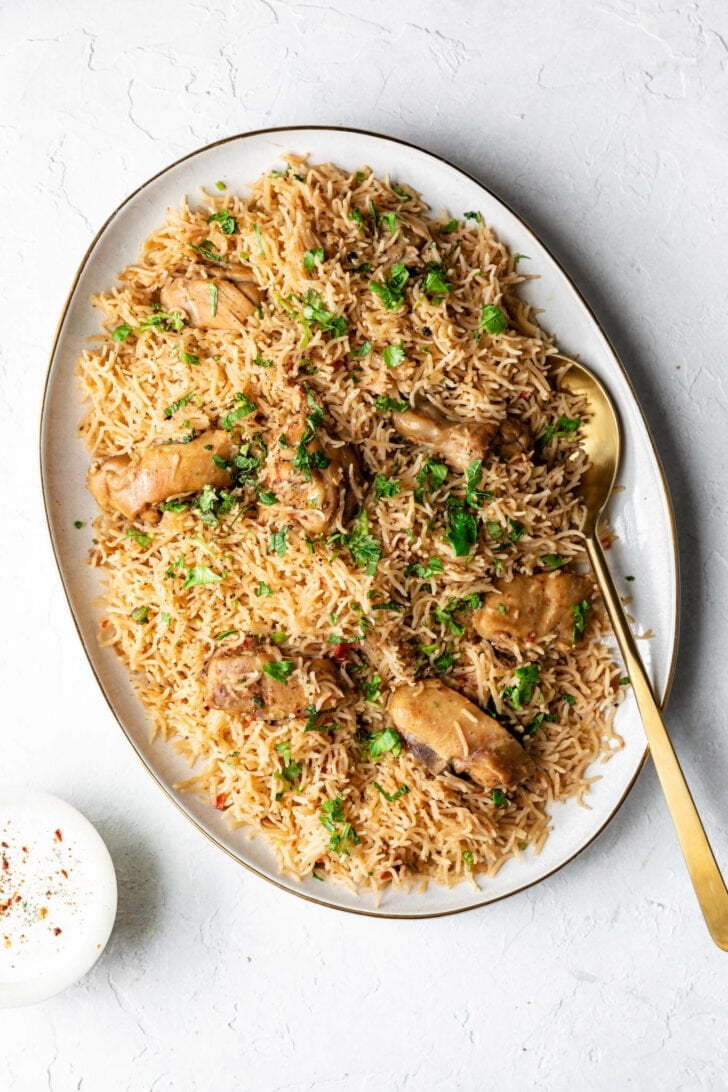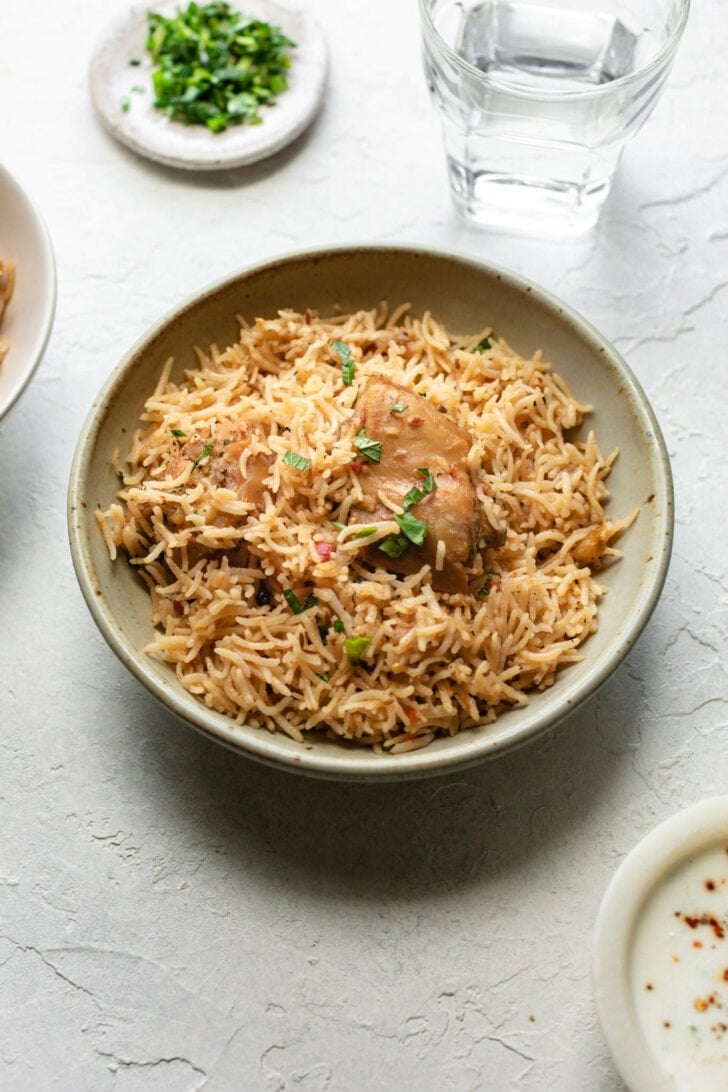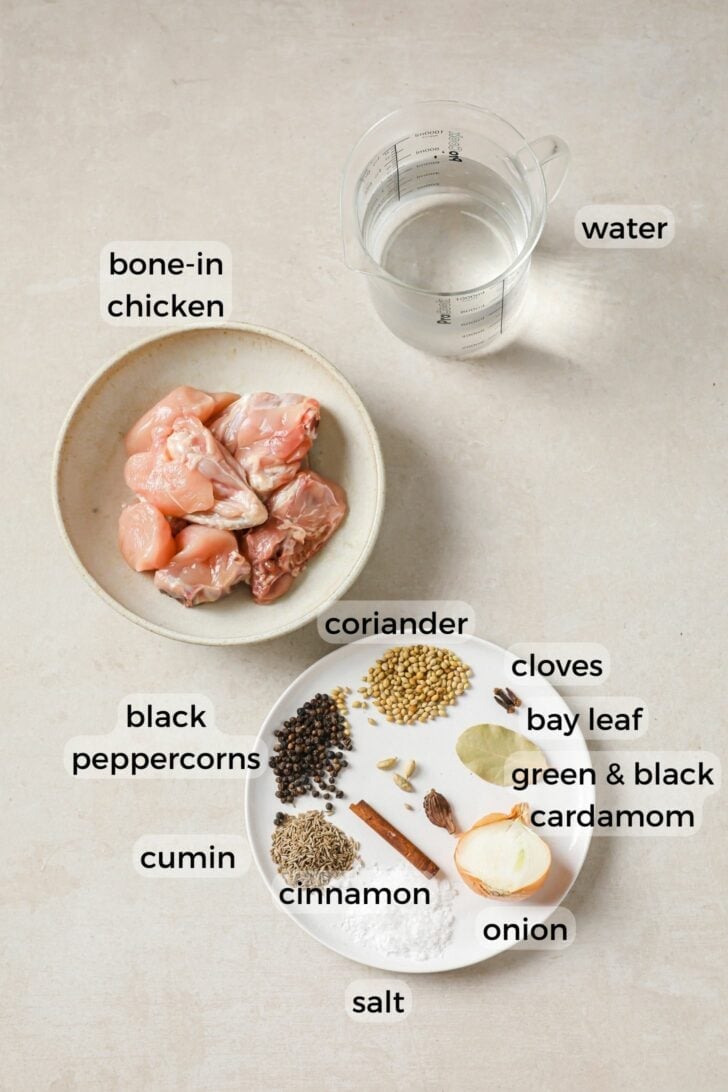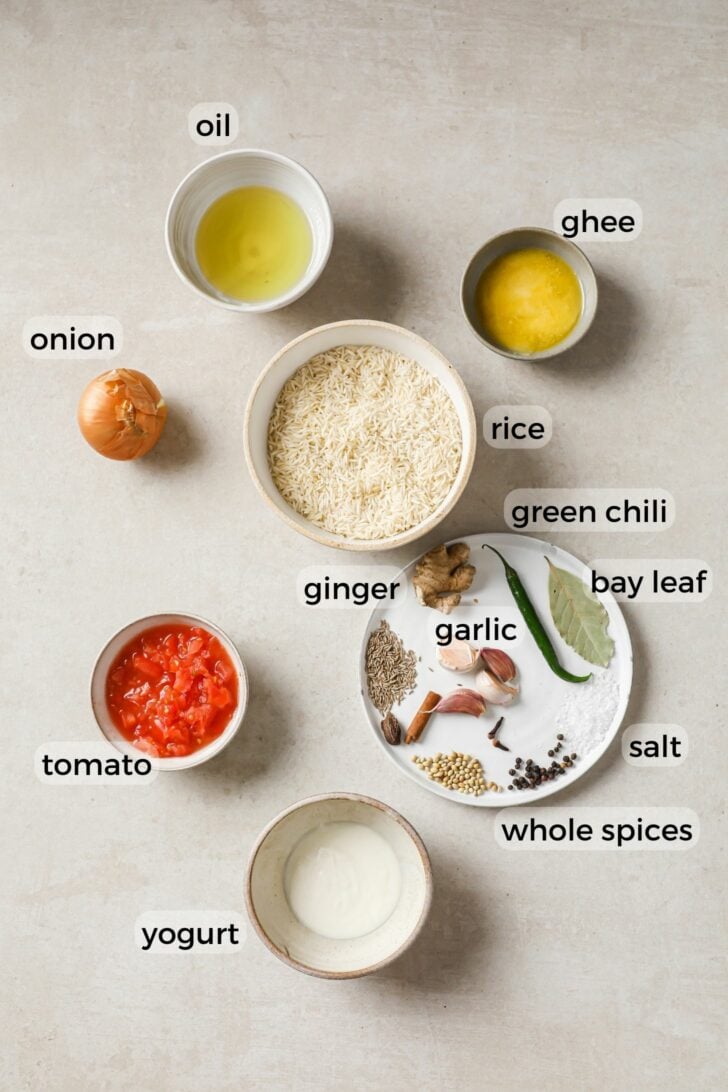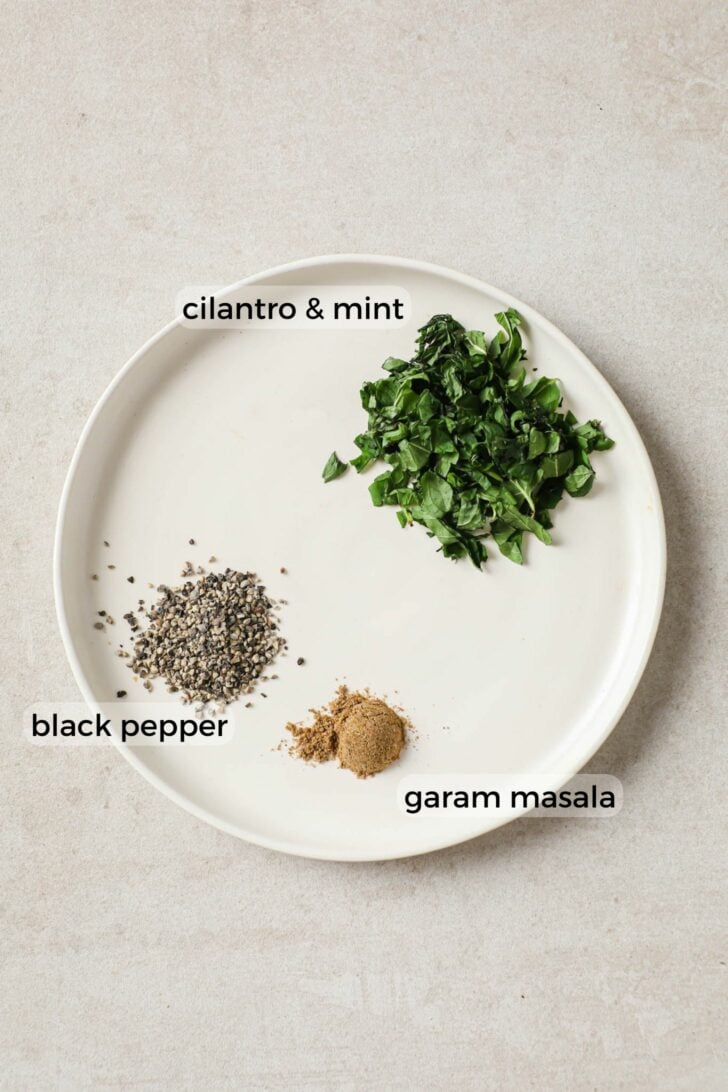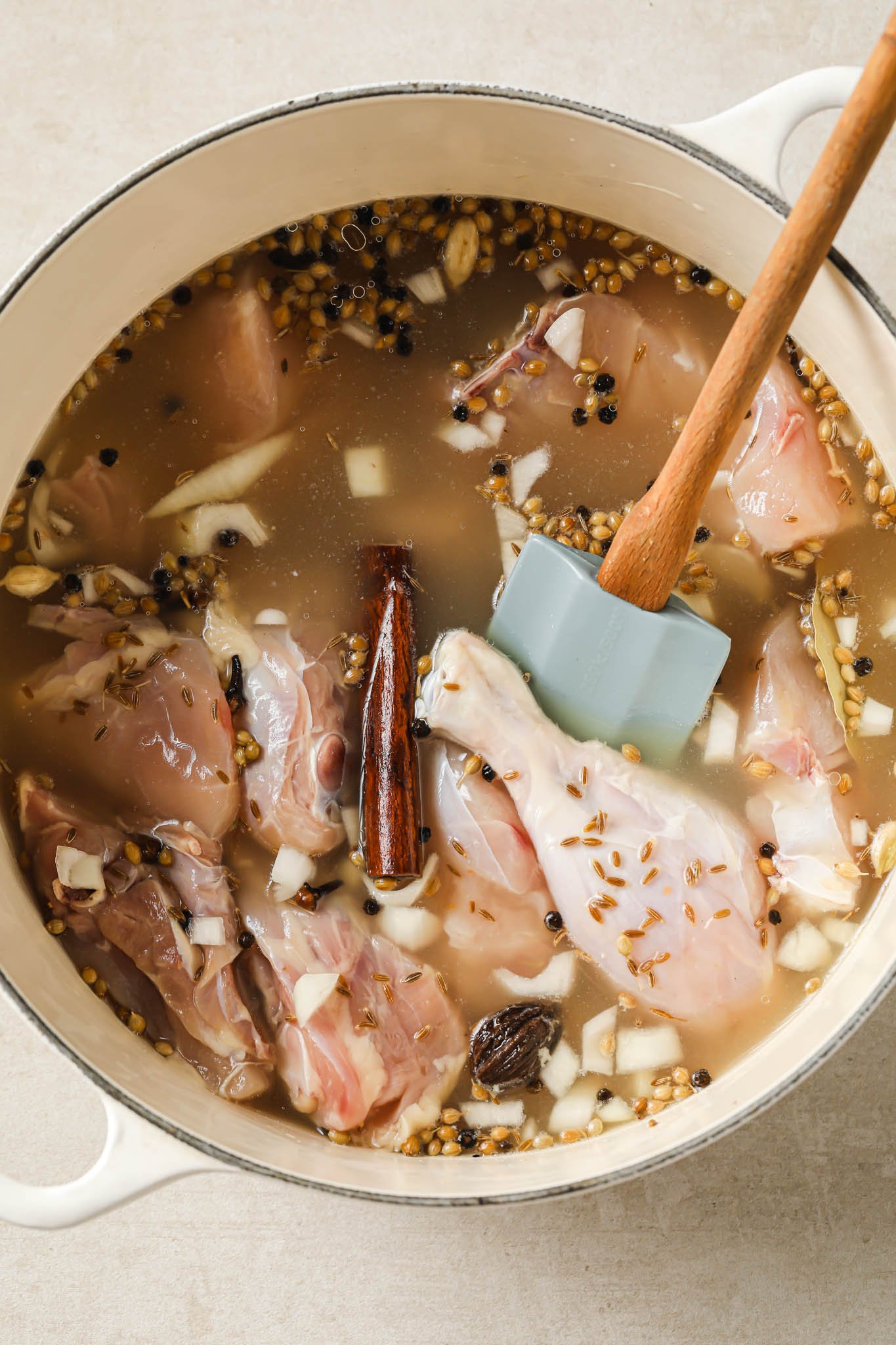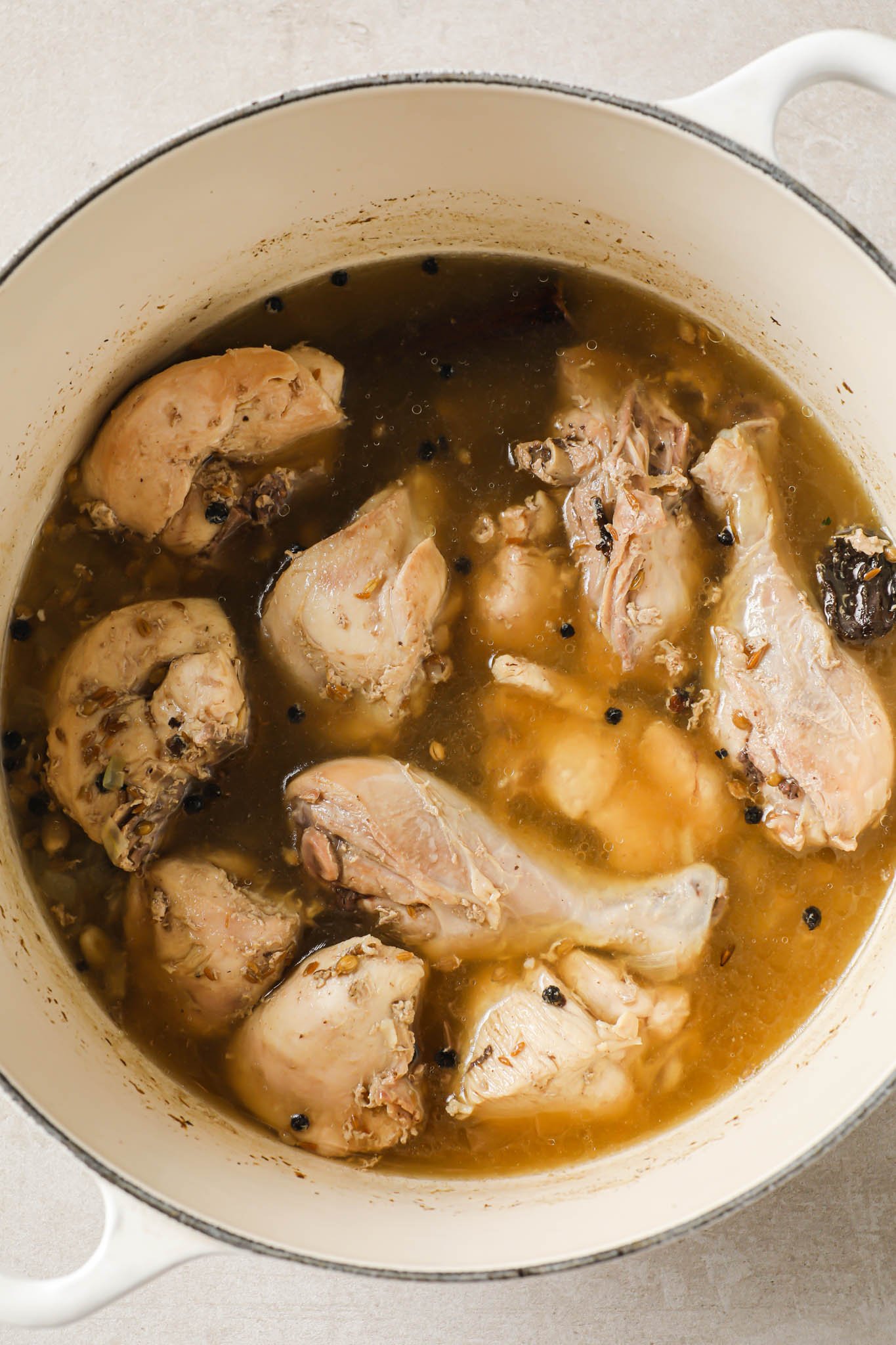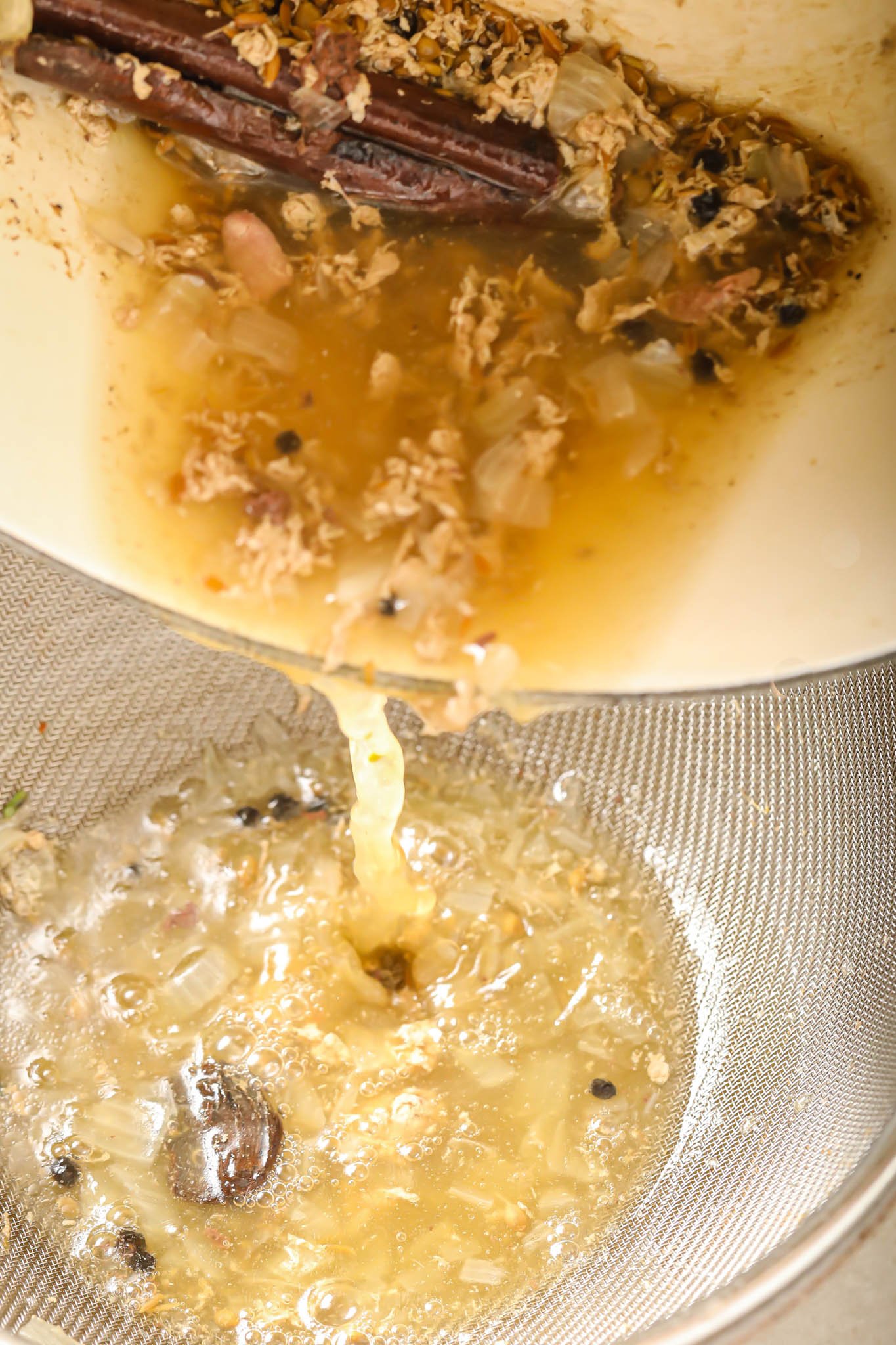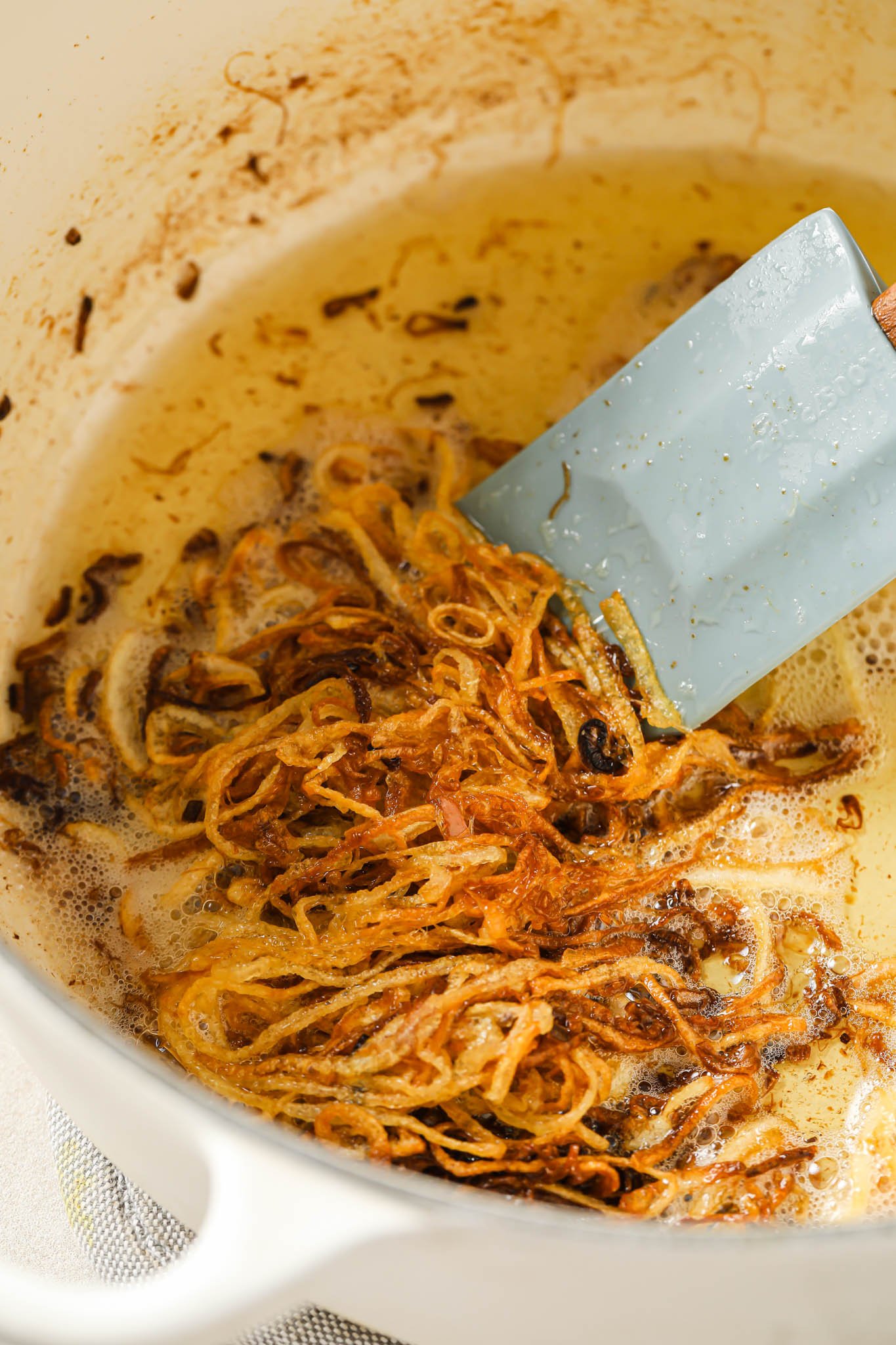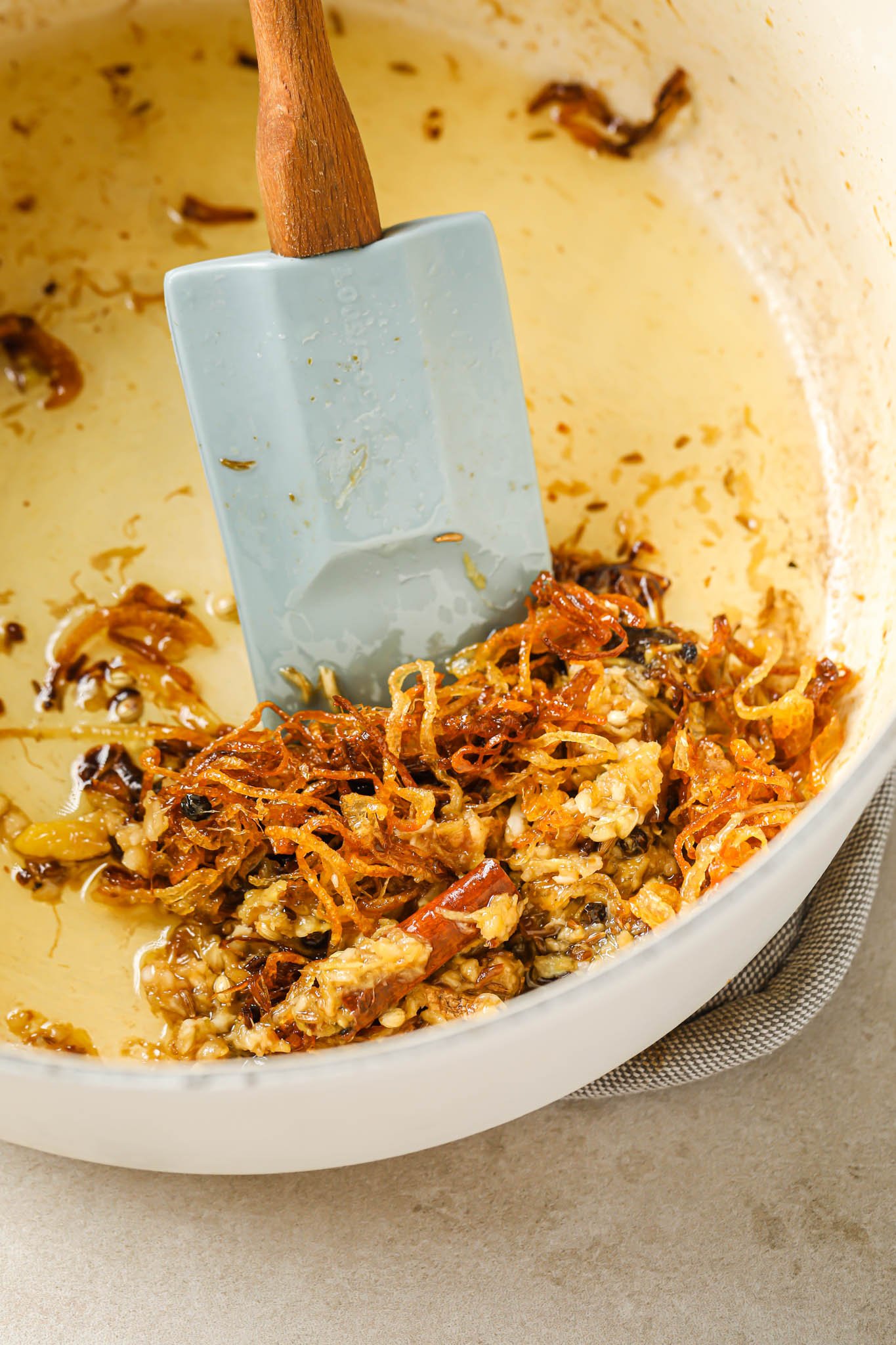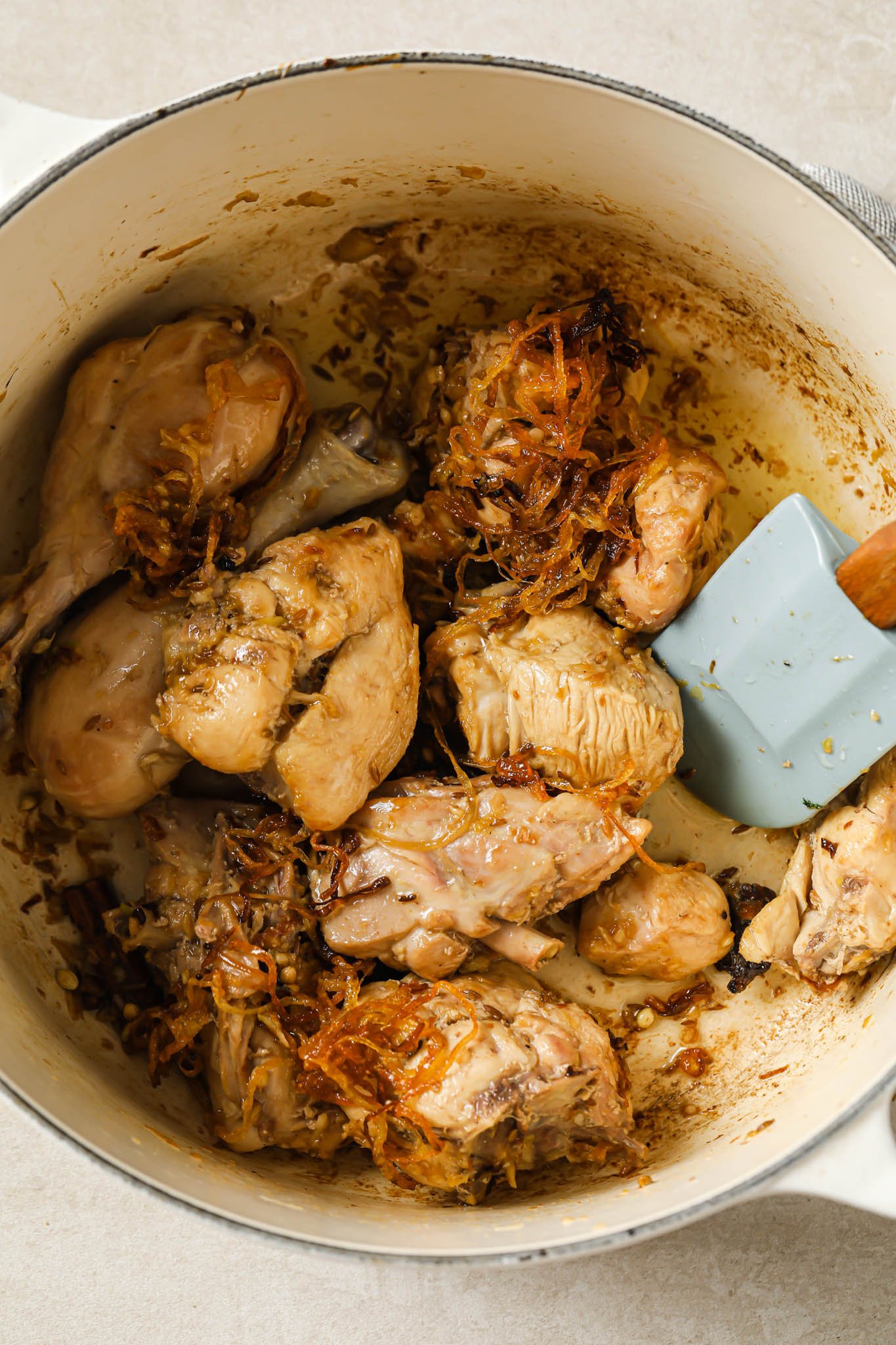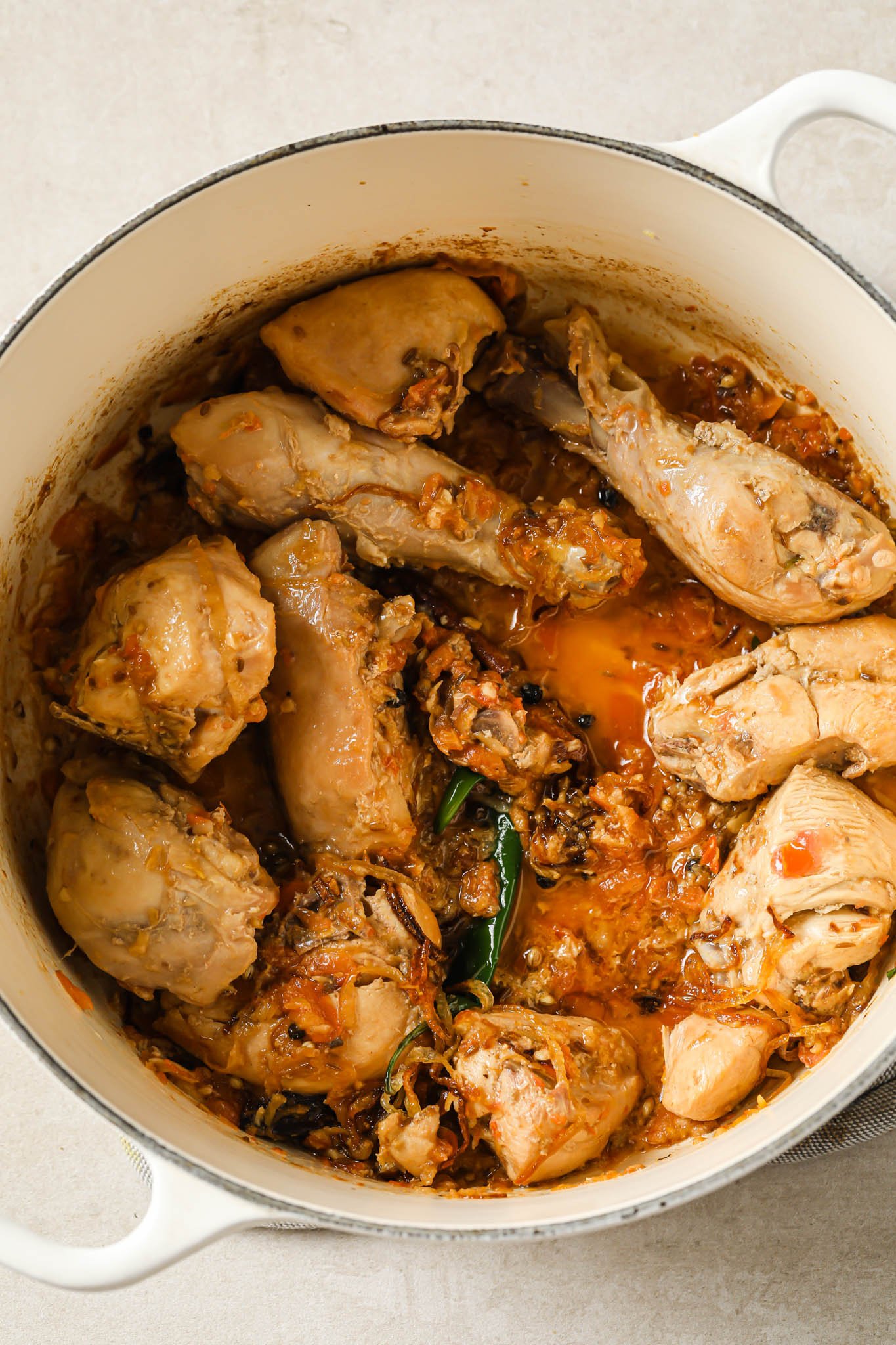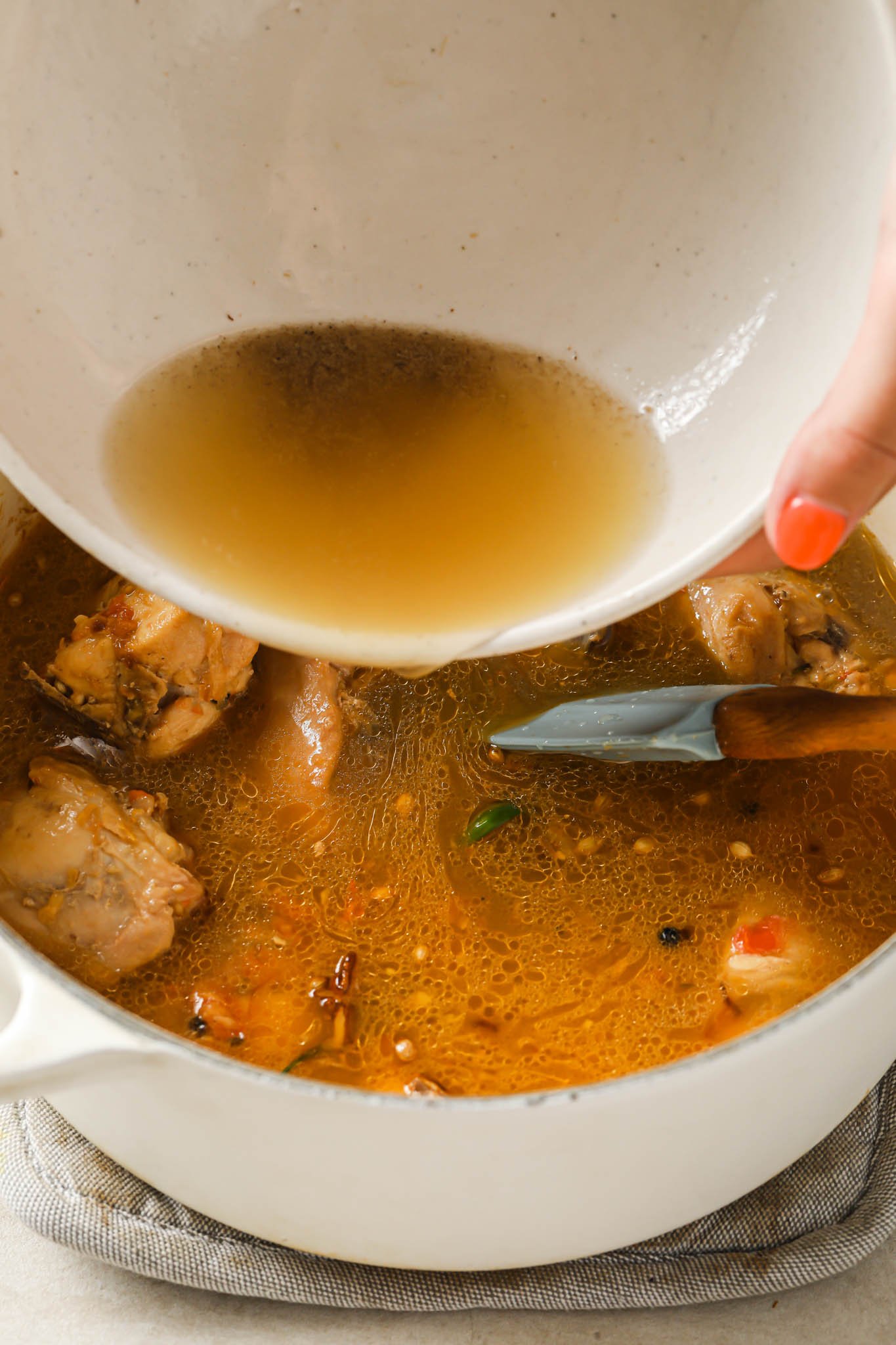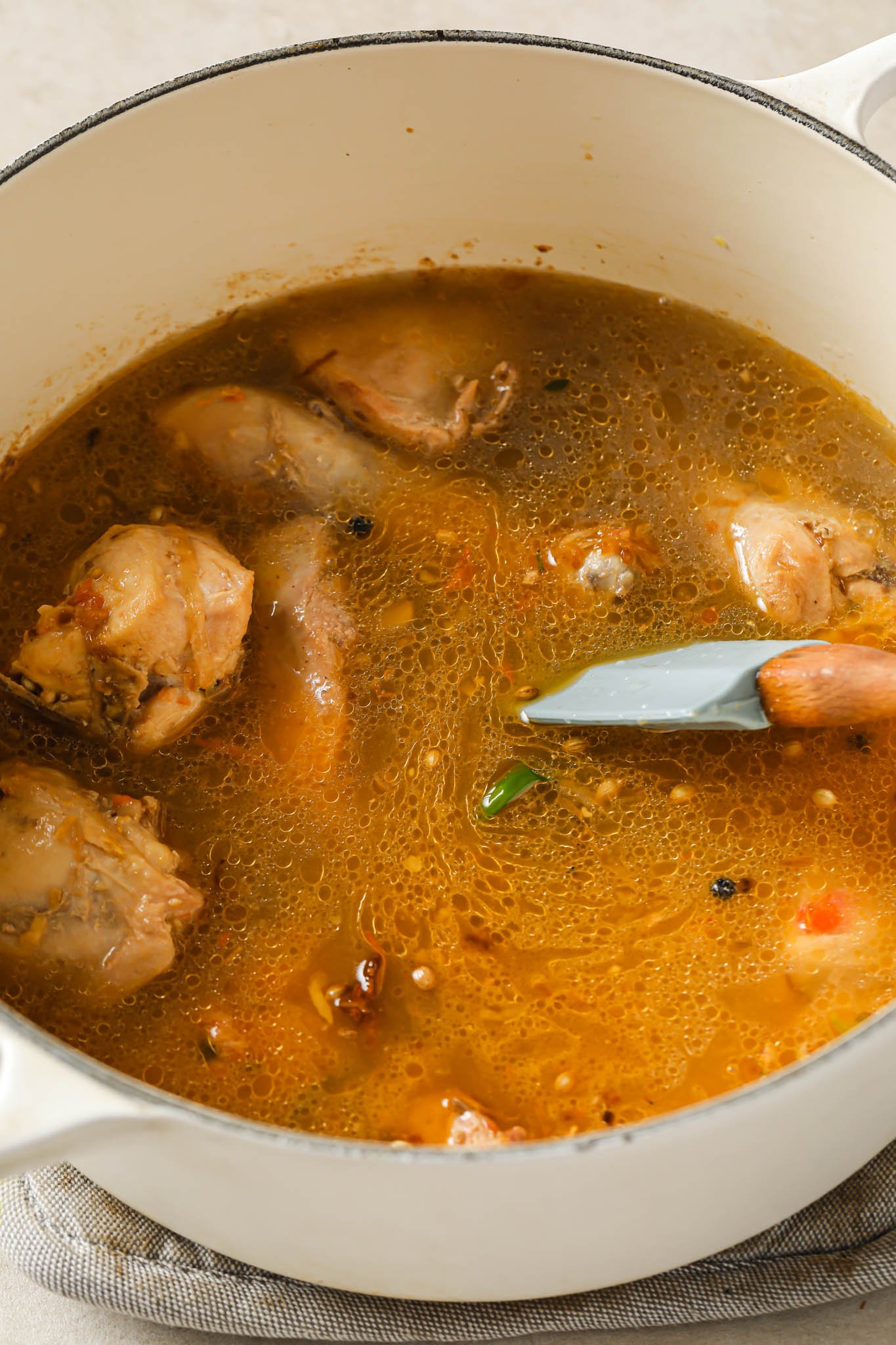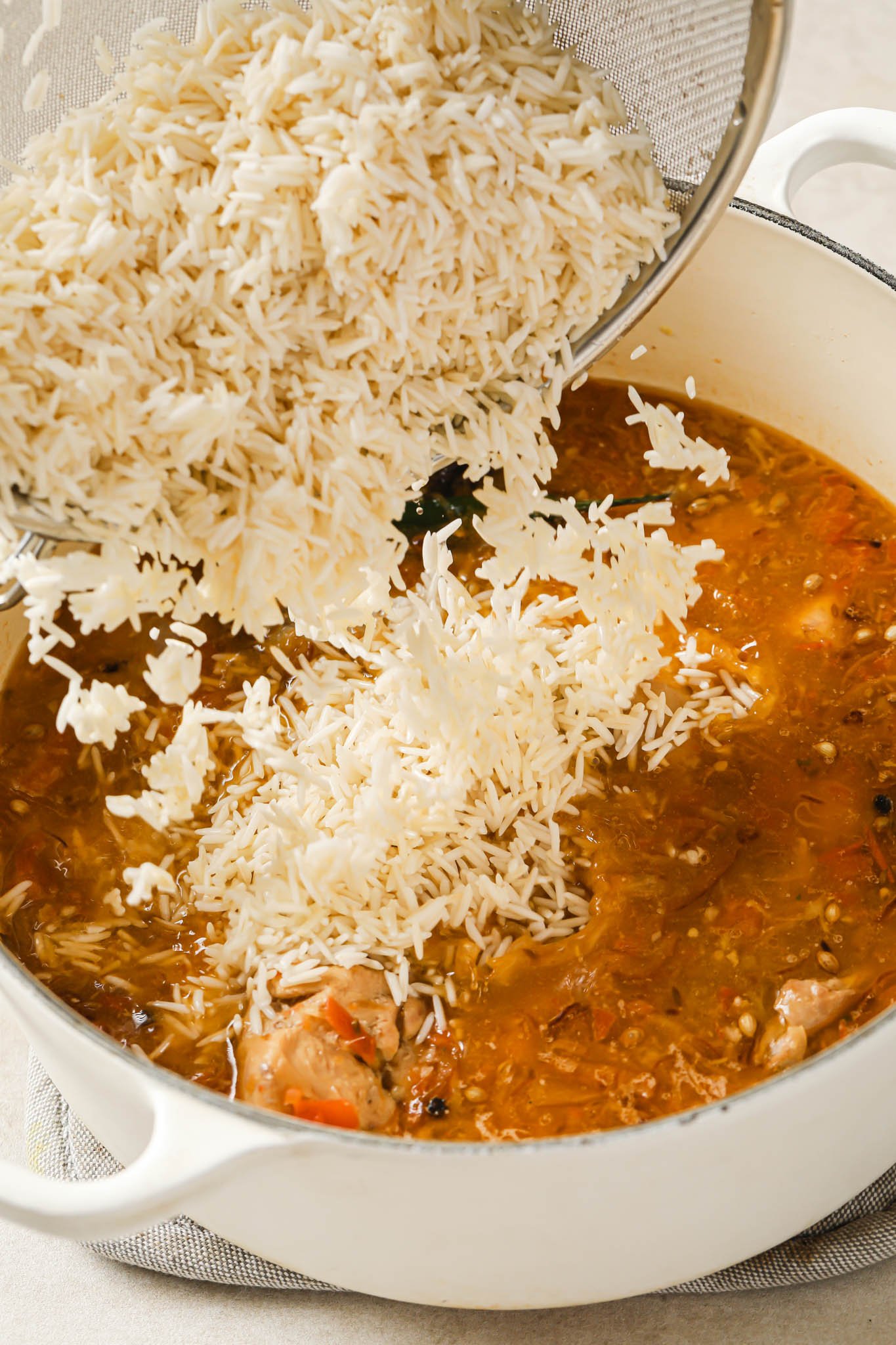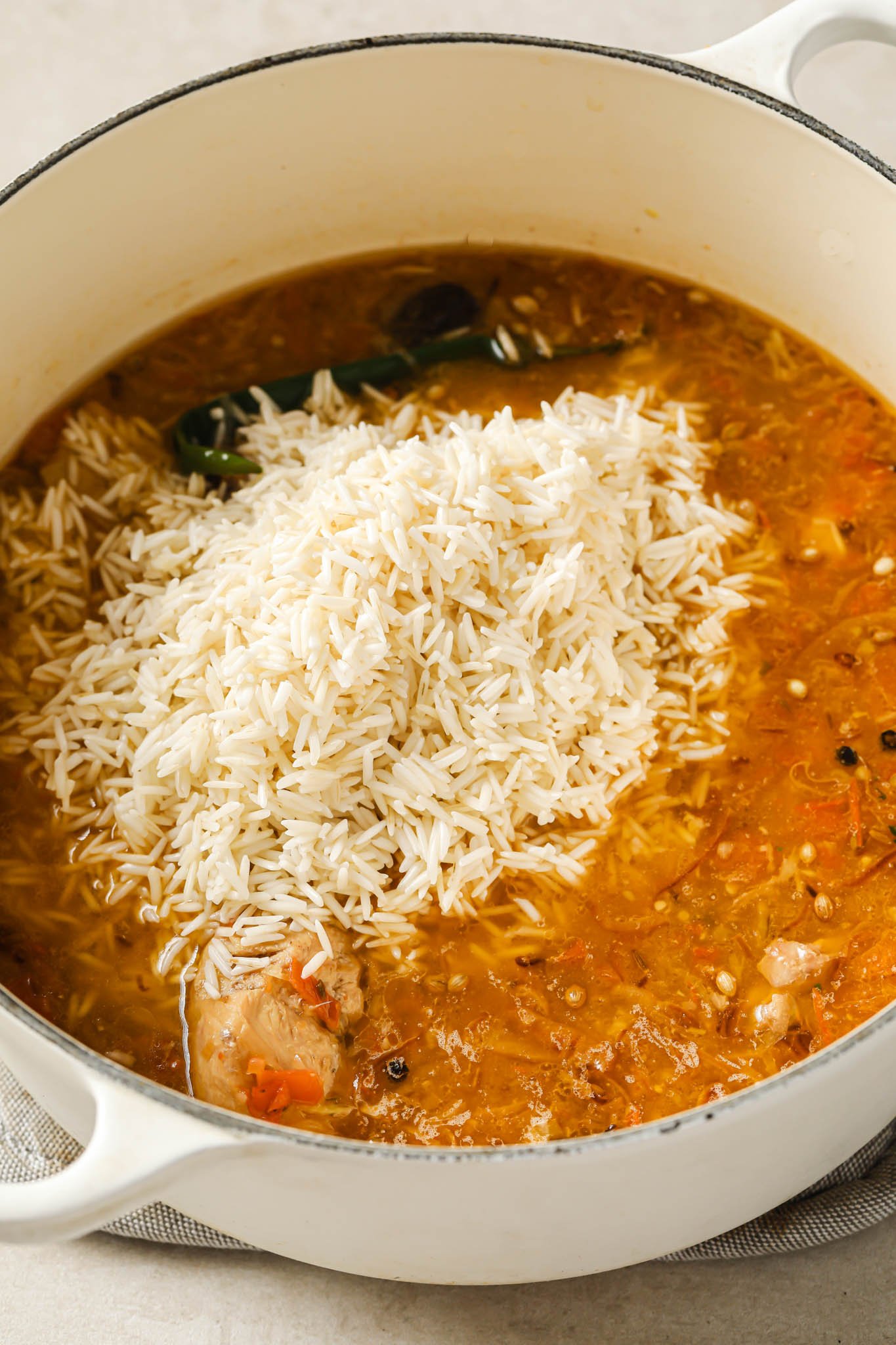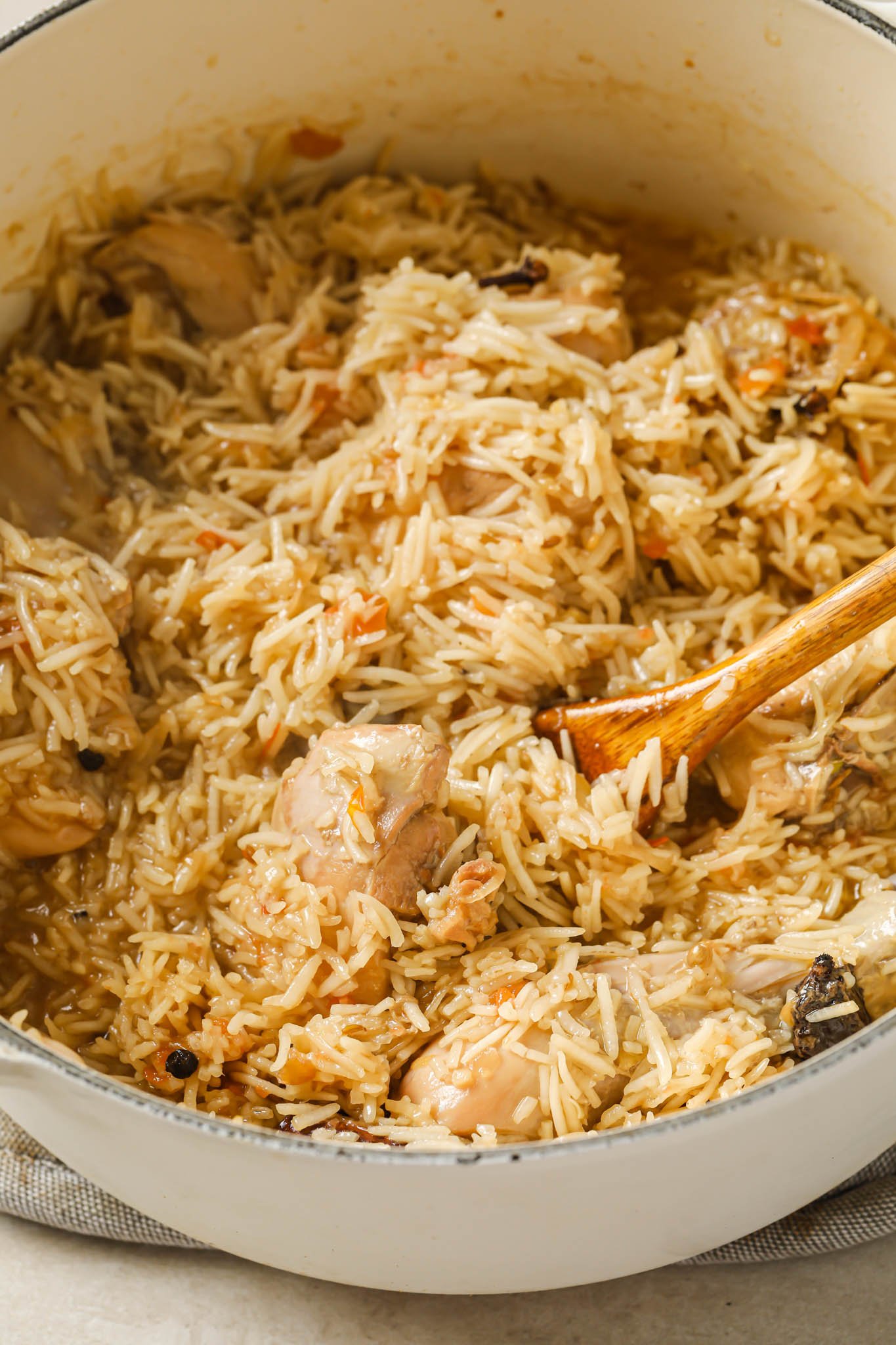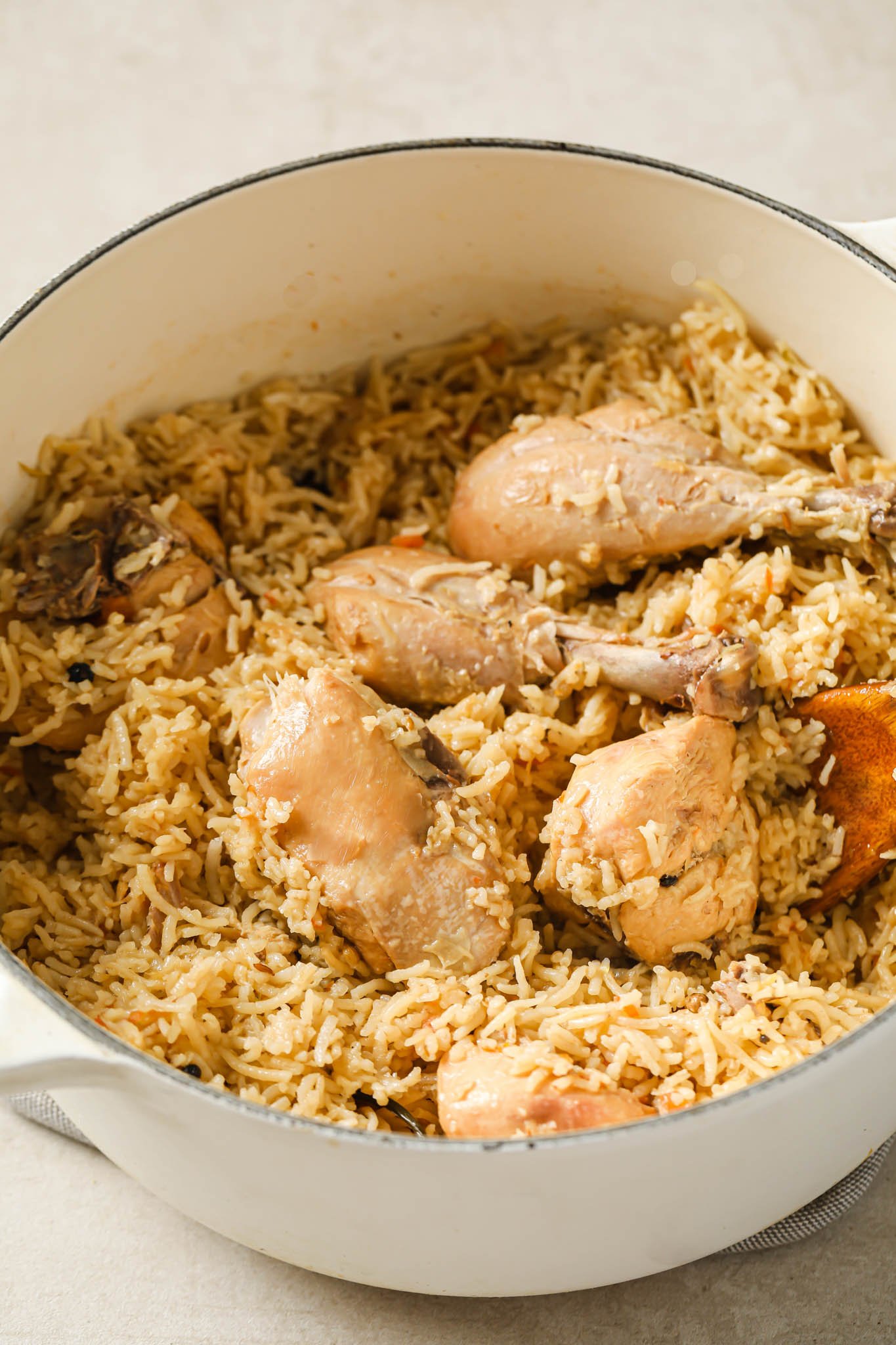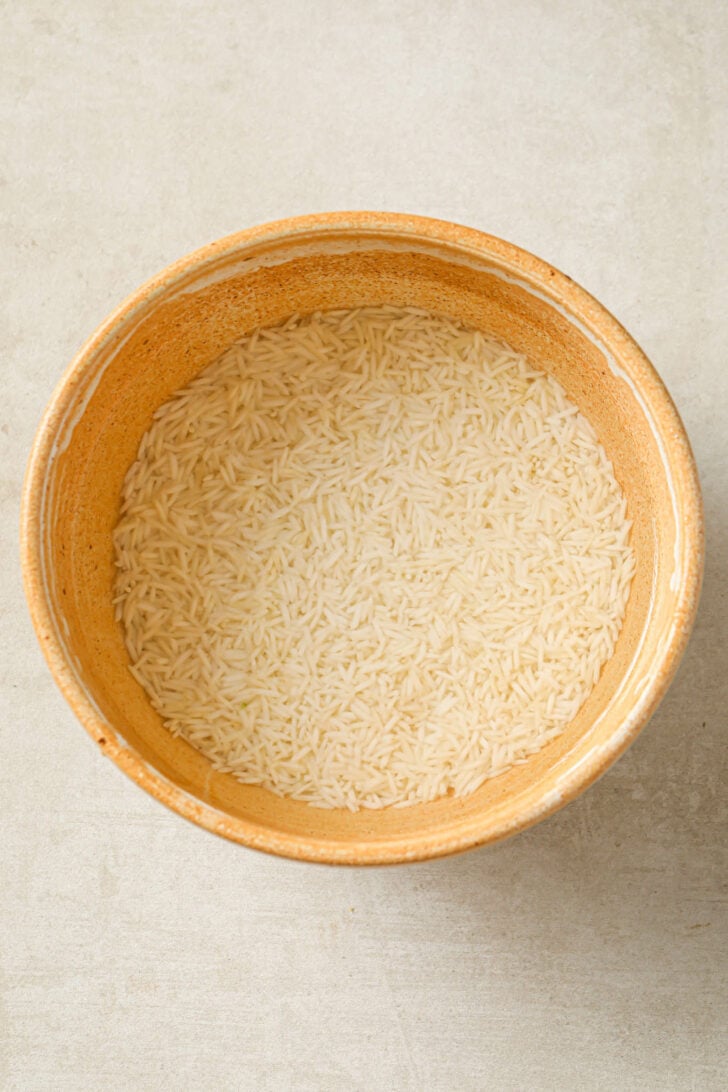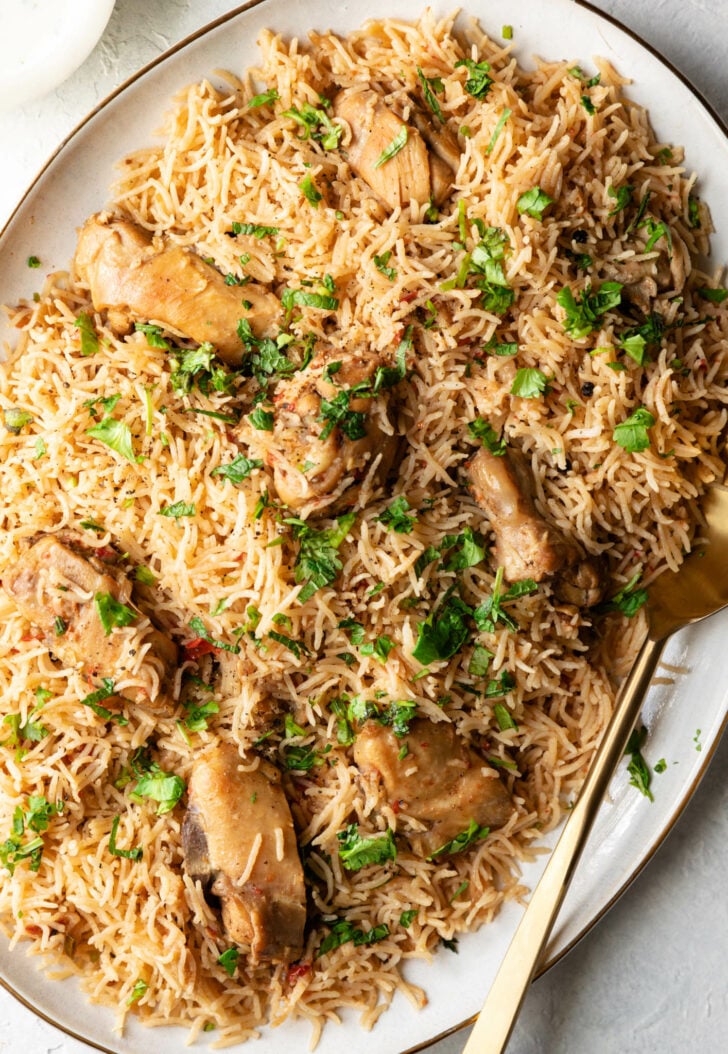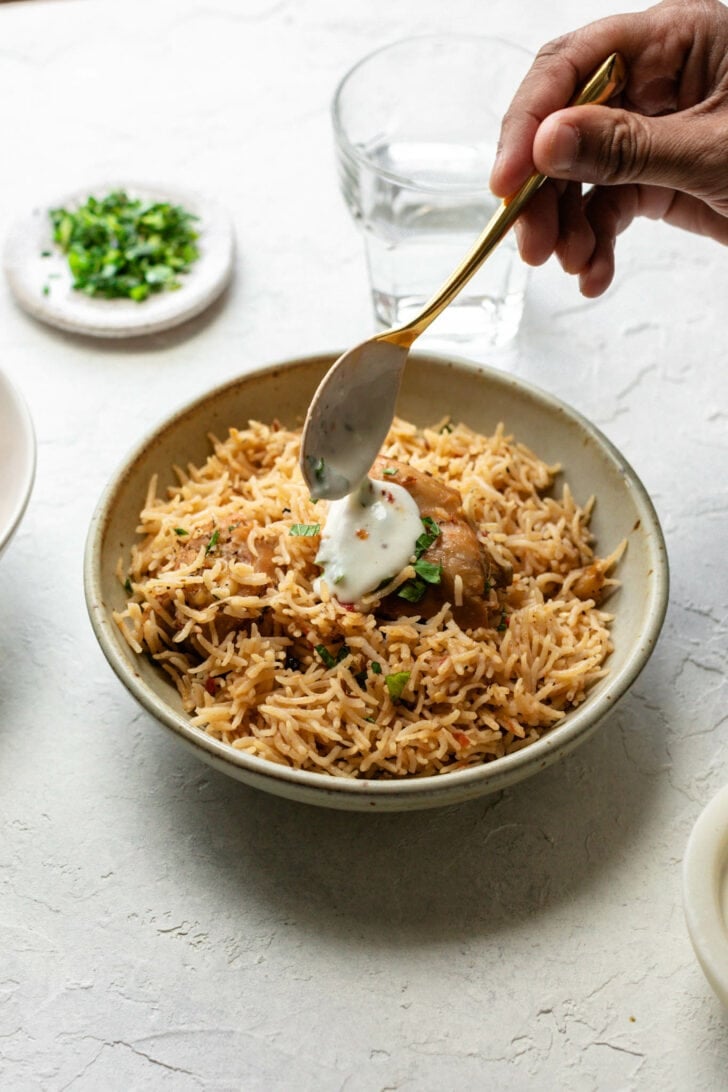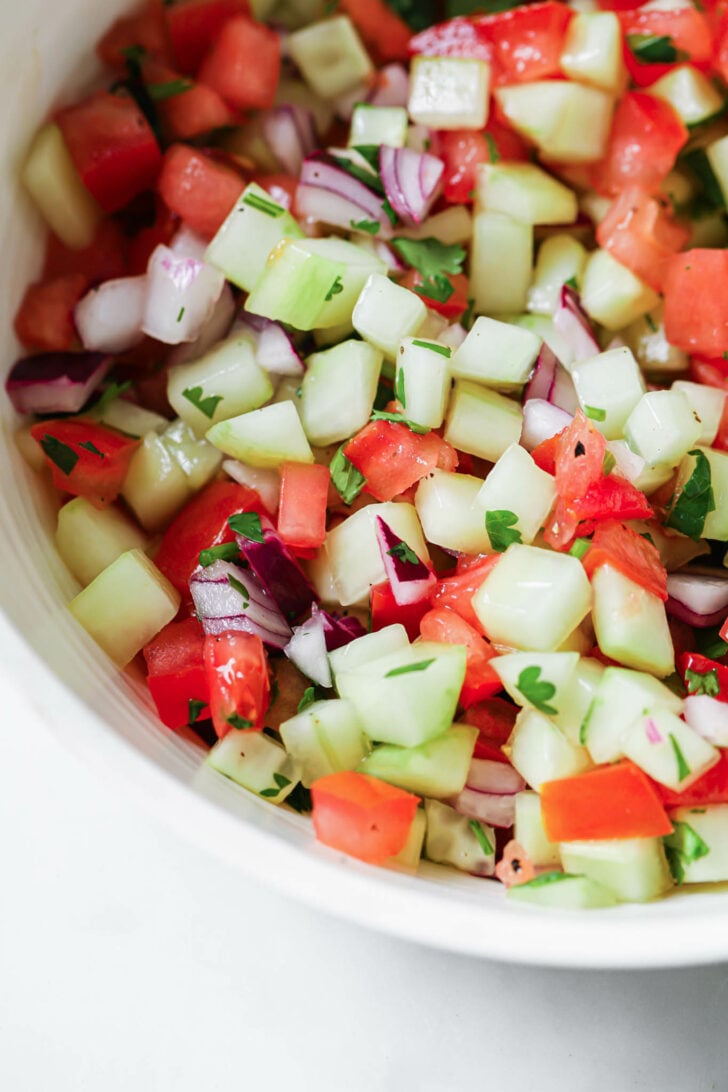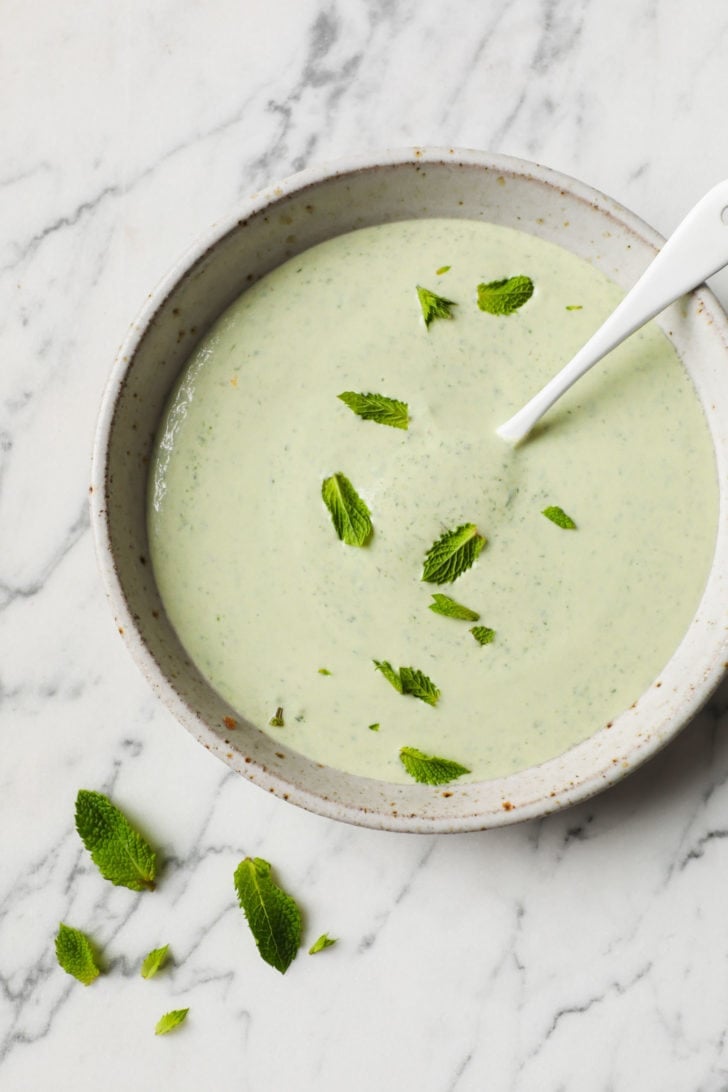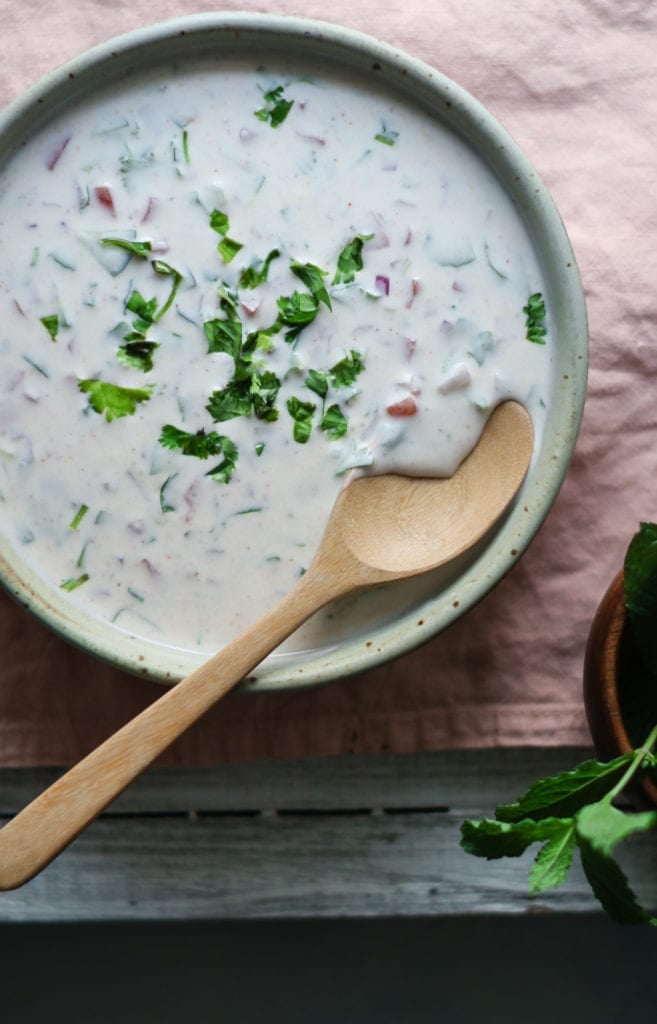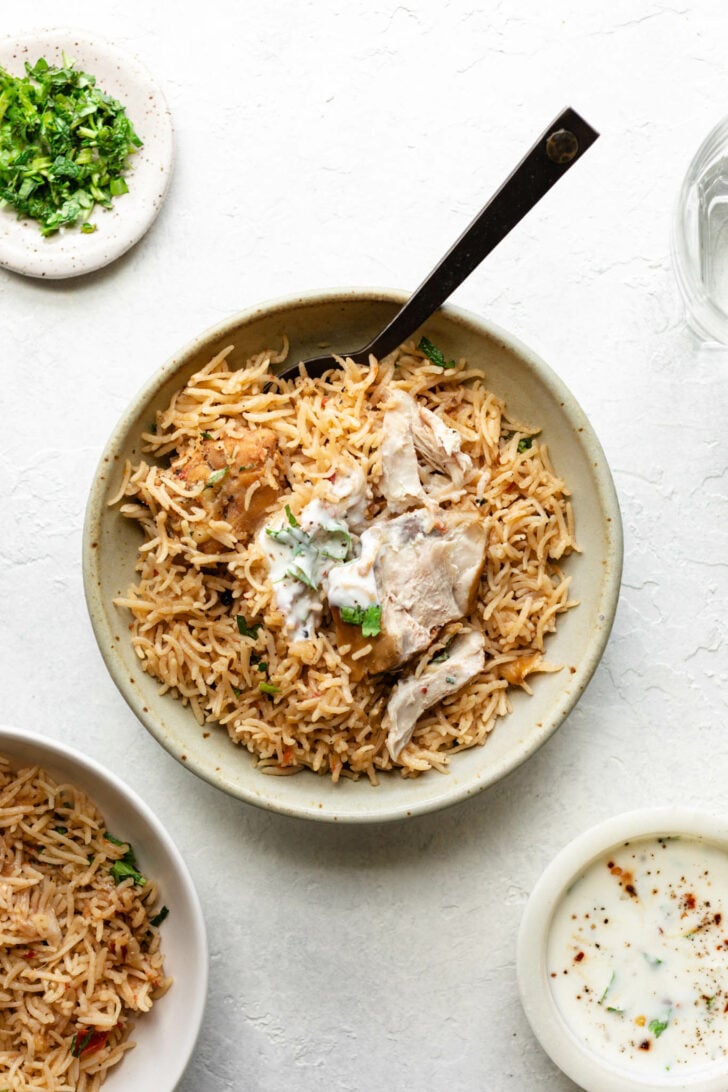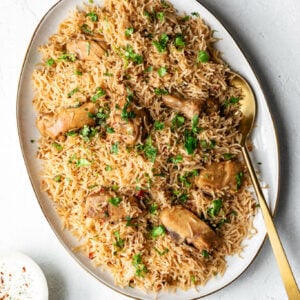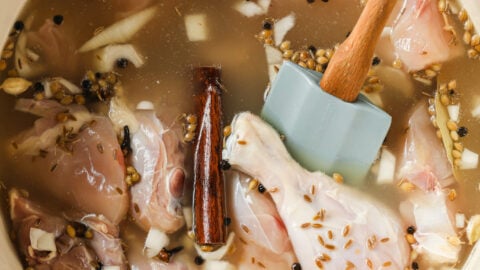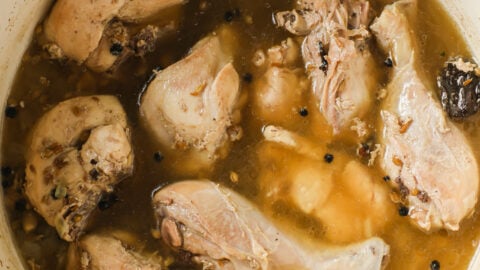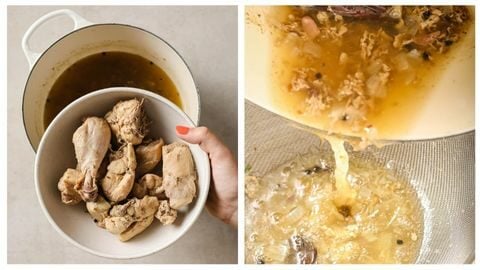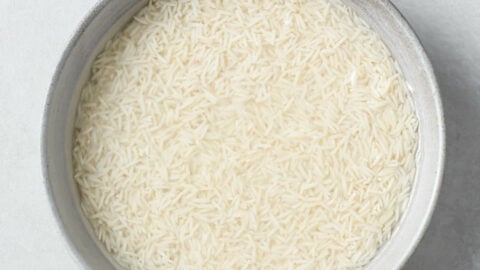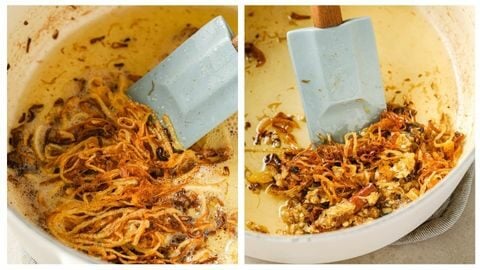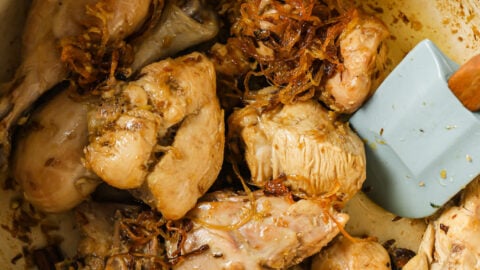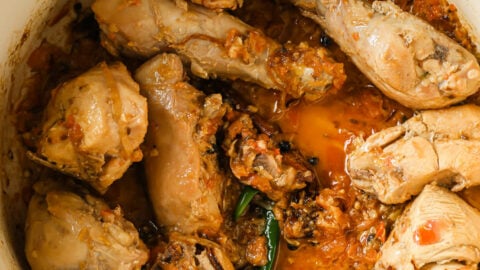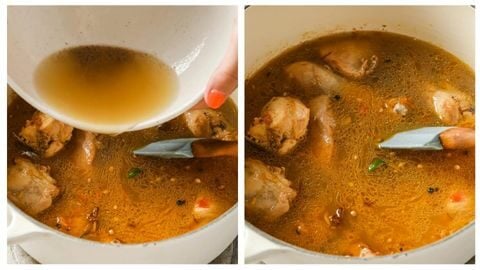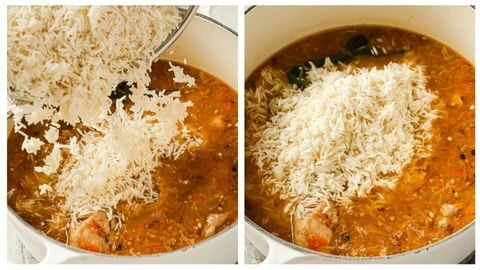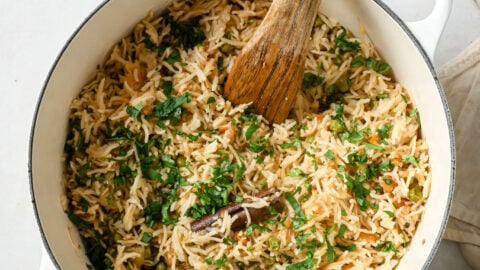Slowly but lovingly, I’ve been chipping away at this Chicken Pulao recipe for years. Pulao (also spelled Pilau), a delicately spiced rice dish, is a tad behind (truthfully, very far behind) Chicken Biryani in popularity. A Houston restaurant owner once told me he’d have to throw out the Pulao every night because nobody would pick it over Biryani. Enter your email below and get it sent straight to your inbox. Plus, get recipes & tips every week! But it’s close to my heart nonetheless. Growing up in a Punjabi household meant that Pulao was on the table much more frequently. These days, I often make it for guests when I need a festive, yet simple main dish that pairs well with just about everything.
Yakhni Pulao vs Non-Yakhni Pulao
Yakhni just means broth or stock. So Yakhni Pulao is made by simmering bone-in meat to create a broth, which is then used to cook the rice.
55.6% found getting the rice right the trickiest part of making pulao. 37% thought getting the taste right was the trickiest aspect. And, much to my dismay, a whooping 69.5% prefer their pulao without tomatoes.🥲
Without Yakhni, Pulao is a one-pot meal cooked in aromatics, protein or vegetables, whole spices, and water. Examples include Mutton Pulao, Matar Pulao, Chana Pulao or Instant Pot Chicken Pulao (which, by the way, is a wonderful weeknight stand-in for this more immersive Yakhni Pulao recipe.) But, dare I say the better way to make pulao is to make it with a proper Yakhni. Which, yes, takes an extra 25 minutes or so. But that’s a small price to pay for the depth of flavor the broth etches into each bite.
Ingredients for Chicken Pulao
As long as you have your whole spices in tow, Pulao requires simple ingredients:
Broth (Yakhni) Ingredients
Whole spices: You’ll need coriander seeds, cumin seeds, black peppercorns, cinnamon, green cardamom, black cardamom, bay leaves, and cloves. The ratio of the whole spices is balanced so that no one spice is detectable in the final broth. But as always, if you’re missing a spice or two, omit & proceed! Bone-in Chicken: I use cut-up, skinless, whole chicken pieces that are naturally small. I find halal meat markets to have smaller-sized chickens. They weigh around 2.5 lb per chicken as opposed to the 3-4 lb chickens you’ll see at supermarkets. Using goat (mutton), lamb, or beef in place of chicken: Use my new Mutton Pulao recipe! The main difference is an increase in cook time for the meat, which will consequently require more water. Goat or lamb meat will take about 2 hours of gentle simmering. Beef will take longer, roughly 3 hours. You want to ensure the stock is concentrated, so only top with as much water needed to cook the meat. Onion: I’ve used yellow onion here but red onion works just as well. You don’t have to follow the onion quantity exactly, but know that pulao gets its beautiful color from not just from the browning of onions, but also the amount of onions.
Chicken Pulao Ingredients
Ghee & oil: As usual, I love blending both for a balance of flavor and fluidity. Plain, whole-milk yogurt: Whisked, room temperature yogurt is the way to go to prevent curdling, but you’ll be fine even if you plop it in cold. It’ll eventually meld in with the broth and rice. Feel free to increase the yogurt if you’re not using tomatoes. To keep it dairy-free, omit yogurt but use the tomatoes. Tomatoes: I use Roma because of the lower water content. As I mentioned earlier, most people prefer pulao without tomatoes. I love the vibrant flavor they add, but I’ve tried the pulao without them and it was still beautiful. So, with a heavy heart, I’ve made the tomatoes optional. Aged, long-grain basmati rice: I use Royal’s Chef’s Secret, aged, long-grain basmati rice. Through feedback about my Instant Pot Chicken Pulao and Rice Cooker Basmati Rice, I’ve learned that this rice is tougher and is more resilient to excess liquid than other types of rice. That said, any rice will work as long as it’s aged, long-grained rice. More whole spices: Though the stock is infused with the flavors of the whole spices, I still find them essential within the rice. 1 – Blooming them in oil brings out a different element of their flavor and 2 – Just like in Chicken Biryani, whole spices within the dish make it festive and wholesome. That said, if you’d rather not have any whole spices in the pulao, feel free to either add more spices to the stock, or substitute with 1/2 tsp ground garam masala while making the pulao. Green chili peppers: I use 2 Thai chili peppers or 1 serrano for an appropriate amount of kick. Of course, you can adjust this amount as you’d like.
Garnish Ingredients
Black Pepper & Garam Masala Powder: I use these ground spices for a final touch of aroma and texture. They’re not strong or distracting to the final dish, but you can use less or omit if you prefer not to use. Cilantro & Mint: I add these after cooking the rice so they maintain flavor and color. I find mint leaves to be a non-negotiable in Chicken Pulao, but cilantro alone works just fine.
How to make Chicken Pulao (Key Tips)
The first thing you’ll do, and I find this the easiest part, is make the stock. Just throw in all stock ingredients and allow it to gently simmer away until the chicken is cooked.
How to Cook the Chicken Perfectly
For tender chicken with maximum flavor, you want to ensure it cooks in the gentlest heat possible. For more robust flavor, you can allow it to rest for a couple hours or refrigerate up to 48 hours. To prevent the cooked chicken from breaking while it’s sautéing (“bhunai“), make sure it’s just cooked but not falling off the bone. This takes my chicken around 20 minutes. When in doubt, take a bite. If you could eat it as-is, turn off the heat.
Use a tong or slotted spoon to remove the chicken from the stock, then strain the stock. Discard the remaining spices and onion. Next, measure the broth and add water as needed to make 2 3/4 cups. Simple evaporation science says that simmering the liquid will reduce it. But, with the lid on and the containment of chicken juices, mostly I’m right where I started – 2 3/4 cups.
In all pulaos, the onions will determine the color of your rice. It’s important to be patient with them, stir frequently, and deglaze the pan to help them brown evenly. You also don’t want to brown them too much before adding the garlic and ginger because they’ll continue to brown until you add the acidic ingredients like tomatoes and yogurt.
Sauté the chicken so that you can see color go from pale to lightly golden, but not too long or it’ll darken. Stir in the tomatoes (if using), yogurt, and green chili peppers and sauté gently so the chicken doesn’t break. Once the oil starts to separate, you’re ready to add the broth. Troubleshooting tip: If you find that the chicken has indeed cooked too much and is starting to break, use a tong to remove it from the pan and continue with the recipe. Then gently stir back in after the rice comes to a boil.
Add the broth and bring to a boil. Then drain the rice well so you’re not adding any excess water.
While you’re bringing everything back up to a boil, this is a good time to do a final salt test, as the rice has begun to take up some of the salt. Now let’s move on to the final, never-again-intimidating step: cooking the rice perfectly!
How to Cook the Rice Perfectly
To start, you want to ensure basic rice essentials such as gently washing the rice until the water runs clear and soaking according to the recipe. For the pot, I’ve found a non-stick Dutch oven (5.5 quart) to be the best at preventing the rice from sticking to the bottom. Once all this is in place, here are a few tips to ensure perfect rice, every time.
Know your Rice
Rice to water ratio: From the survey, I learned that to cook 1 cup of basmati rice, most people use anywhere between 1.5 to 2 cups of water. 1.5 cups of my rice (Royal Chef’s Secret Extra Long) needs 3 cups to cook on the stovetop, but for this recipe I accommodate for the extra moisture from the other ingredients. If you cook rice often, use your usual ratio. So if you normally use 1.5 cups of water per 1 cup of rice, I use 2 1/4 cup broth for 1.5 cups of rice.
Do Not Disturb
Avoid stirring while cooking: I learned this tip from my friend Kathryn at Cardamom and Tea and, surprisingly, also from my rice cooker. Once the rice starts cooking, just let it be. Stirring runs the risk of breaking the rice kernels and interfering with the buildup of heat. Let it rest even after steaming: Keep the lid on even after you’ve turned off the heat. As Kathryn says, “leaving the rice covered will allow it to gently coast to perfect doneness.” This final rest is crucial and can cover any prior misgivings. Don’t stir even after cooking: The only reason to stir cooked rice is because resting the rice too long can make it clumpy or stick to the bottom. Use a rice paddle (not a fork) to fluff, but stirring, especially with a fork, increases the risk of breaking the rice kernels.
Simmer, Then Steam
Pulao is generally made by simmering the rice until most of the water has absorbed or evaporated, and then turning the heat down for a final steam, or dum.
Simmer, don’t boil: The key here is to keep the heat on medium or medium-high so that it simmers, but doesn’t aggressively boil. This gives the long grains time to soak up the liquid as it cooks off. To cover or not to cover: I’ve tried letting the rice simmer uncovered, partially covered, and fully covered. My happy medium (i.e. the least likely to mess with the water/rice ratio) is when the lid is partially covered.
How to Steam (Dum)
How to know it’s ready to steam: When most of the water from the surface has absorbed or evaporated and you begin to see something like potholes forming in the top layer of the rice (see video!), it’s ready for a final steam. Cover the lid with a cloth: I use old kitchen linens or a cotton cloth. The goal is to contain the steam while absorbing any extra moisture that could otherwise lead to soggy rice. Lastly, relax: Remember, if you’ve given your rice enough time to cook, even if you steam a little too soon or a little too late, you’ll be fine. There’s plenty of give with the steaming with cloth + resting method.
What to Serve with Pulao
For me, the only essential side is a cooling bowl of cucumber raita, mint raita, or yogurt. Serve with Kachumber Salad, or fresh, crunchy vegetables chopped up with a bit of salt, pepper, and lemon juice. Often, pulaos are accompanied with kebabs such as Chapli Kabab, Aloo ki Tikki, Shami Kabab, or Seekh Kebab. For parties, you can bulk up the spread with traditional dishes such as Kofta Curry, Aloo Gosht, or Korma. Interestingly, my husband’s family eats pulao with Zarda, though I still haven’t acquired a taste for this combo.
How to Double the Recipe
This recipe is perfect for doubling because a double quantity uses a whole, 2.5 lb chicken and feeds a crowd (8-12 people). I actually developed this recipe in its double form because I’d always test it when I had guests coming. 😇 Here’s how to do it:
Double all the ingredients, including whole spices and water. Use a larger pot (8-10.5 qt). Increase the sauté and simmer times by 2-3 minutes.
Tried this recipe? If you have a minute, please consider leaving a comment telling me how it was! You can also take a quick picture and upload it directly into the comments. If you’re on Instagram, please tag me so I can see your creations. I truly love hearing from you. Thank you!
